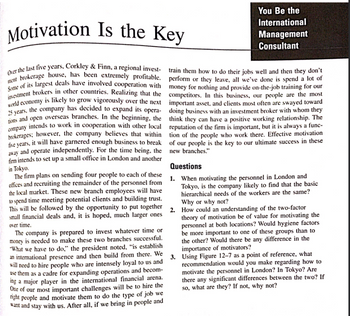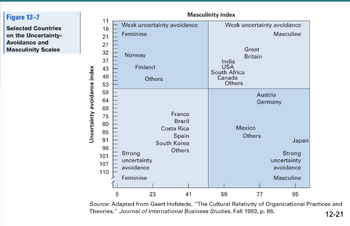
Use Attached paragraph top answrer questions
When motivating the personnel in London and Tokyo, is the company likely to find that the basic hierarchical needs of the workers are the same?
Why or why not?
How could an understanding of the two-factor theory of motivation be of value for motivating the personnel at both locations? Would hygiene factors be more important to one of these groups than to the other? Would there be any difference in the importance of motivators?
Using Figure 12-7 as a point of reference, what recommendation would you make regarding how to motivate the personnel in London? In Tokyo? Are there any significant differences between the two? If so, what are they? If not, why not?

Step by stepSolved in 5 steps

Here is the requested 12-7 image! Thank you!

Here is the requested 12-7 image! Thank you!

- Use Section to answer Questions: When motivating the personnel in London and Tokyo, is the company likely to find that the basic hierarchical needs of the workers are the same? Why or why not? How could an understanding of the two-factor theory of motivation be of value for motivating the personnel at both locations? Would hygiene factors be more important to one of these groups than to the other? Would there be any difference in the importance of motivators? Using Figure 12-7 as a point of reference, what recommendation would you make regarding how to motivate the personnel in London? In Tokyo? Are there any significant differences between the two? If so, what are they? If not, why not?arrow_forwardWhat type of motivation resonates with you and why? (intrinsic/extrinsic)? How will you motivate someone who does not identify the same as you?arrow_forwardDiscuss how managers can apply esteem needs from maslow's 5 step motivational theory as a motivational tool for staff of a can foods compamyarrow_forward
- How you can apply the Alderfer’s ERG theorie of needs to motivate employees? Clearly define the theory and how it can be used? Write 5 esxamples.arrow_forwardHow you would use the following theories to motivate your employees. Be very detailed and support what you say. Goal Setting TheorySelf-Efficacy TheoryEquity Theory/Organizational JusticeEmployee Involvementarrow_forward5. Discuss, how emotions at work effects on employee performance?arrow_forward
- Discuss how you would use 1 of hertzbergs motivators to improve the level of staff motivation at the company.arrow_forwardIn the context of the motivation/hygiene theory, which of the following is considered a motivator? A) Interpersonal relationships B) Supervision C Recognition D Working conditions 4 OF 10 QUESTIONS REM Question 10 25 Doinarrow_forwardScenario # 1: Theories of Work Motivation Your company provides diversity training programs to ensure that employees realise the importance of working witha diverse workforce, are aware of the equal employment opportunity legislation, and are capable of addressing thechallenges of working in a multicultural workforce. Participation in these programs is mandatory, and employees arerequired to take the training as many times as needed until they pass. The training program lasts one day and is usuallyconducted in a nice hotel outside the workplace. Employees are paid for the time they spend in the training program.You realise that employees are not motivated to perform well in this program. During the training, they put in theminimum level of effort, and most participants fail the examination given at the conclusion of the training programand then have to retake the training. Question a. Give A definition of process theories of work motivation.arrow_forward
- Please provide one example for each of the attitudes as predictions of behavior. These examples must be a healthcare employee Definition of three attitudes as predictions of behavior is attached below Thank youarrow_forwardwhat actions do workers and or bosses take at a workplace to increase motivation?arrow_forward
 Understanding BusinessManagementISBN:9781259929434Author:William NickelsPublisher:McGraw-Hill Education
Understanding BusinessManagementISBN:9781259929434Author:William NickelsPublisher:McGraw-Hill Education Management (14th Edition)ManagementISBN:9780134527604Author:Stephen P. Robbins, Mary A. CoulterPublisher:PEARSON
Management (14th Edition)ManagementISBN:9780134527604Author:Stephen P. Robbins, Mary A. CoulterPublisher:PEARSON Spreadsheet Modeling & Decision Analysis: A Pract...ManagementISBN:9781305947412Author:Cliff RagsdalePublisher:Cengage Learning
Spreadsheet Modeling & Decision Analysis: A Pract...ManagementISBN:9781305947412Author:Cliff RagsdalePublisher:Cengage Learning Management Information Systems: Managing The Digi...ManagementISBN:9780135191798Author:Kenneth C. Laudon, Jane P. LaudonPublisher:PEARSON
Management Information Systems: Managing The Digi...ManagementISBN:9780135191798Author:Kenneth C. Laudon, Jane P. LaudonPublisher:PEARSON Business Essentials (12th Edition) (What's New in...ManagementISBN:9780134728391Author:Ronald J. Ebert, Ricky W. GriffinPublisher:PEARSON
Business Essentials (12th Edition) (What's New in...ManagementISBN:9780134728391Author:Ronald J. Ebert, Ricky W. GriffinPublisher:PEARSON Fundamentals of Management (10th Edition)ManagementISBN:9780134237473Author:Stephen P. Robbins, Mary A. Coulter, David A. De CenzoPublisher:PEARSON
Fundamentals of Management (10th Edition)ManagementISBN:9780134237473Author:Stephen P. Robbins, Mary A. Coulter, David A. De CenzoPublisher:PEARSON





